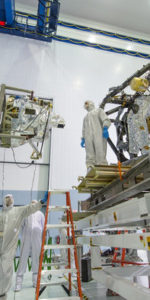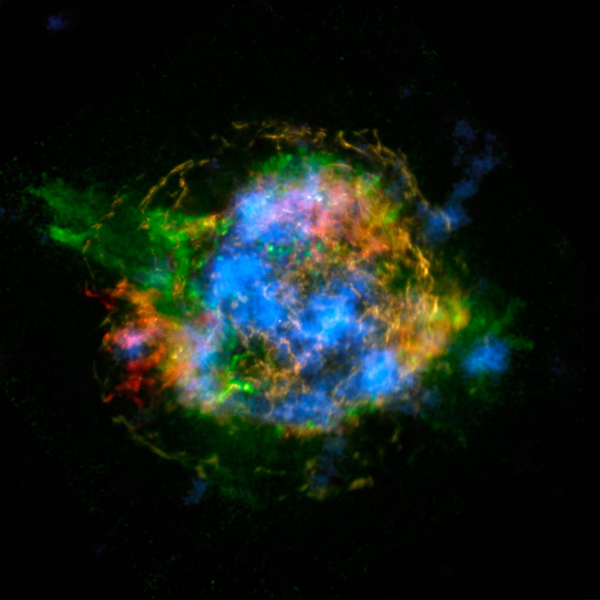
New and exciting observations from NASA’s Nuclear Spectroscopic Telescope Array, or NuSTAR, hint at a possible solution to one of the most intriguing mysteries of modern astrophysics: What is the exact mechanism that drives supernova explosions?
Supernova explosions are among the most energetic phenomena in the Universe, signifying the death of big, supermassive stars. During the explosion, most of the star’s mass is violently ejected into interstellar space, seeding the interstellar medium with all the heavy elements that were created inside the star’s core, allowing for the creation of a newer generation of stars and planetary systems. What is left behind after the explosion is the former star’s core, having a mass several times that of the Sun compacted into an area no bigger than San Francisco. The ejected inner layers of the star create an expanding shock wave of material that collides with and sweeps through the interstellar medium, creating structures called supernova remnants, or SNRs, that can span many light-years across interstellar space.
The two main causes of supernova explosions are the accretion of matter around white dwarfs in binary star systems and the core collapse of a very massive star. In the latter case, when the star’s core runs out of fuel and can no longer sustain nuclear fusion reactions at its center, the star collapses onto itself from its own gravity. During the collapse, the star’s inner layers bounce off the now burnt-out core, triggering such a violent and energetic explosion that during its peak it can outshine an entire galaxy.
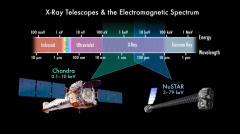
Supernova explosions and their remnants have been studied extensively within the Milky Way and other galaxies by many different ground- and space-based observatories in multiple wavelengths during the last several decades. NASA’s Chandra X-ray Observatory in particular has provided astronomers with very detailed views of SNRs in the high-energy part of the electromagnetic spectrum, helping to reveal their elemental composition. Yet the exact processes that drive these cataclysmic cosmic events have for the most part remained unknown. Astronomers always knew that supernovae explode, but they were uncertain as to how. The reason is that previous X-ray observatories like Chandra and XMM-Newton didn’t have the capability to observe in the energies needed to peer into the cores of these explosions and unravel their hidden mechanisms. Astronomers were in need of a space telescope able to observe the high-energy X-rays that were invisible to previous observatories.
Their needs were met with the launch of NASA’s NuSTAR X-ray telescope in June 2012. Whereas Chandra and XMM-Newton can observe at the low-energy part of X-ray wavelengths between 0.1 and 10 KeV, NuSTAR can see all the way from 3 to 79 KeV, at the high-energy part of X-rays. This superior observing capability allows NuSTAR to study high-energy physics phenomena in the Universe like never before, around supernovae, black holes, active galactic nuclei, and other exotic celestial objects.
During a media teleconference that was hosted by NASA on February 19, the NuSTAR science team detailed the fascinating observations made by the X-ray observatory of Cassiopeia A, a supernova remnant inside our Milky Way galaxy, located approximately 11,000 light-years away in the constellation Cassiopeia. As per science publishing guidelines, the team’s study was published the same day in the journal Nature.
“The results we’re unveiling today are the first-ever map of radioactive material in the remnants of a star that exploded in an incredibly powerful event, called a supernova,” said a jubilant Fiona Harisson, principal investigator for NuSTAR. “This is helping us to untangle the mysteries of how stars explode and in particular what’s happening at the very heart of the explosion. No other telescope could make this map, because previous imaging telescopes don’t go to high-enough energy.”
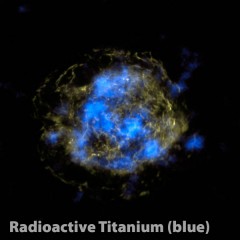
NuSTAR was able to map the distribution of the radioactive isotope Titanium-44 at the heart of Cassiopeia A by detecting the element’s X-ray emission. Titanium-44 is a highly unstable isotope that decays into calcium-44, while emitting very-high energy X-rays in the process. Its presence was invisible to previous observations by other X-ray telescopes because it only glows in the high-energy X-ray wavelengths that NuSTAR can observe.
The progenitor stars of supernova explosions that are caused by core collapse develop a layered internal structure throughout their lifetime that resembles that of an onion. These stars start their lives by fusing hydrogen into helium, deep in their cores. When the hydrogen is depleted they continue to burn the helium that has been created previously, converting it to carbon, which in turn is converted to neon and so forth, with the star’s core fusion process progressing up through the periodic table of elements, producing progressively heavier atomic nuclei all the way to iron. When the star reaches this stage, it can no longer sustain any fusion reactions and it collapses under its own weight, resulting in a supernova explosion. Although Cassiopeia A most probably exploded sometime between 1667 and 1680, with the supernova remnants expanding away ever since, NuSTAR’s observations have for the first time revealed to astronomers the presence of the actual elements that have been created during the time of the supernova explosion itself. “With NuSTAR we have new forensic tools to investigate the ashes left behind when the star exploded,” said Caltech astronomer Brian Grefenstette and member of the NuSTAR team, during the teleconference. “When it starts to explode, it leaves behind clues that we can use to figure out what happens when the star collapses and produces the elements that make up us. Now, one of the clues is the image of radioactive titanium, that we see with NuSTAR, which can tell us what was going on down at the guts of the explosion.”
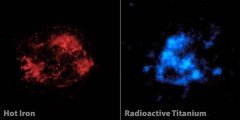
An unexpected result to come out of NuSTAR’s observations is that the distribution of titanium-44 doesn’t match the distribution of iron that had been detected inside Cassiopeia A from previous observations with Chandra. Researchers had hoped that since both iron and titanium are created together at the time, their distributions inside the supernova remnant would match exactly. Yet that weren’t the case. “We were surprised when we looked at the images and found that the two maps obviously didn’t match,” said Grefenstette. “This means that either we were wrong and that there’s iron that’s hidden in the center of Cassiopeia A that is unseen by Chandra because the material is too cool, or something more exotic is going on, that is changing how the elements were formed in the supernova explosion. Either way, it’s a new puzzle for us to solve.”
What wasn’t so unexpected was that the clumps of radioactive material observed by NuSTAR weren’t elongated toward a certain direction at the sky. Previous models have suggested that a supernova explosion might be driven by elongated jets of material, streaming out from a rapidly rotating star. Yet many of these models have frustratingly failed to produce any supernova explosions in previous computer simulations. There was something really missing in astrophysicists’ understanding of how supernovae really work. NuSTAR’s observations of radioactive titanium-44 inside Cassiopeia A didn’t reveal the presence of any elongated jets. Instead, they indicated that the most possible solution to the puzzle is that prior to the explosion the star’s material near the core is sloshing around like boiling water inside a pressure cooker. And just like steam blowing the top of a pressure cooker, this sloshing motion inside the star creates a shockwave that rips it apart. “Stars are spherical balls of gas, and so you might think that when they end their lives and explode, that explosion would look like a uniform ball expanding out with great power,” said Harrison. “Our new results show how the explosion’s heart, or engine, is distorted, possibly because the inner regions literally slosh around before detonating.”
Video Credit: NASA/JPL-Caltech/Christian Ott
“Now, all this sloshing mechanism has been simulated in a computer before, but the NuSTAR image is the first evidence that this kind of explosion is occurring in nature, and [it means] that we may be on the right track to try to understand how massive stars explode,” added Grefenstette.
Robert Kirshner, a professor of Science at the Harvard-Smithsonian Center for Astrophysics in Cambridge, Mass., although not directly involved with the NuSTAR’s team study, nevertheless provided valuable insight during the teleconference. “NuSTAR is living up to its name in two ways: this is not just nuclear, but it’s new,” remarked Dr. Kirshner. “It is pioneering science and you have to expect, that when you get new results, it’ll open up as many questions as you answer. Now, you should care about this. Supernovae make the chemical elements. So, if you bought an American car, it wasn’t made in Detroit 2 years ago. The iron atoms in that steel, were manufactured in an ancient supernova explosion that took place 5 billion years ago. And NuSTAR shows that the titanium that’s in your uncle Jack’s replacement hip, were made in those explosions too. So, we’re all star dust and NuSTAR is showing as where we came from, including our replacement parts. So, you should care about this, and so should your uncle Jack.”
During the Q&A session of the conference, I had the chance to ask Dr. Kirshner whether supernova explosions were possible during the very early Universe, approximately 15 million years after the Big Bang, that could have led to the creation of the first generation of habitable planets capable of supporting life, as argued in a recent study by Professor Abraham Loeb, also of the Harvard-Smithsonian Center for Astrophysics.
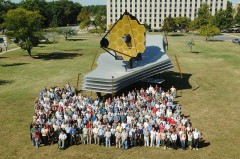
Dr. Kirshner’s answer was as inspiring as it was thought-provoking: “That’s a very interesting question. You know, the human mind is a fallible thing and people’s imagination usually turns out to be less strange than the real world. So, even when something sounds a little strange, nevertheless you shouldn’t be too quick to dismiss it. I don’t think that there’s any question that there will be massive stars that form out of the primordial soup of hydrogen and helium—and we know that something like that must have happened—but this is mostly in the realm if the unobserved. So, if I would have my dream, I would build a really big infrared telescope in space!,” stressed Kirshner, with the excitement evident in his voice. “And of course, that is exactly what we’re doing! We’re building the James Webb Space Telescope, and it will have a pretty good chance I would say, of seeing this first generation of stars—the ones that made the first elements. And we’re gonna do it! Before too long, in a few years, we’re gonna have that JWST, we’re gonna see these stars exploding, we will be able to measure their chemistry, or estimate their properties anyway. I’m very hopeful that we’re gonna go beyond our current knowledge.”
The NuSTAR team plans to further study other supernova remnants as well to try and see whether what was observed in Cassiopeia A is typical of supernova explosions in general. With NuSTAR, astronomers now have for the first time the capability to check theoretical predictions for how exactly massive stars end their lives and how the material from these explosions enriches the interstellar medium with the stuff of life. “Supernovae produce and eject into the cosmos most of the elements are important to life as we know it,” says Dr. Alex Filippenko, Professor of astronomy at the University of California, Berkeley. “These results are exciting because for the first time we are getting information about the innards of these explosions, where the elements are actually produced.”
With all the fascinating discoveries coming from astrophysics observatories currently in orbit like NuSTAR, and from the ones that are scheduled to be launched during the next several years, like the James Webb Space Telescope, we can look forward to a deeply transformational decade in our scientific and human understanding of our place in the Cosmos.
Want to keep up-to-date with all things space? Be sure to “Like” AmericaSpace on Facebook and follow us on Twitter: @AmericaSpace




